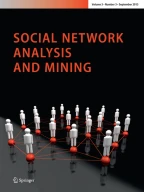Abstract
In this paper, we explore the relationship between two metrics that appear in the literature of social networks, local efficiency and the clustering coefficients. Next, we investigate these properties for a selection of real-world networks involving fMRI data from athletes and show for non-sparse graphs the relationship between the two properties is very close to linear.
Similar content being viewed by others
References
Borgatti S (2006) Identifying sets of key players in a social network. Comput Math Organiz Theor 12:21–34
Cahill ND, Haynes O, Strang A, Narayan DA (2015) Density determined graphs, local efficiencies and clustering coefficients (to be submitted)
Davis JA (1967) Clustering and structural balance in graphs. Human Relations 20(2):181–87
Ek B, VerSchneider C, Narayan DA (2013) Efficiency of star-like networks and the Atlanta subway network. Physica A 392:5481–5489
Freeman LC (1979) Centrality in social networks I: conceptual clarification. Soc Netw 1:215–239
Girvan M, Newman MEJ (2002) Community structure in social and biological networks. PNAS 99(12):7821–7826
Hanneman RA, Riddle M (2015) Introduction to social network methods. Riverside, CA: University of California, Riverside, published in digital form at http://faculty.ucr.edu/hanneman/
Hintz E, Mahon B, Bazarian JJ (2013) fMRI study of collegiate football players at the University of Rochester
Honey C, Kötter R, Breakspear M, Sporns O (2007) Network structure of cerebral cortex shapes functional connectivity on multiple time scales. PNAS 104(24):10240–10245
Lancichinetti A, Fortunato S, Radicchi F (2008) Benchmark graphs for testing community detection algorithms. Phys Rev E 78:046110
Latora V, Marchiori M (2001) Efficient behavior of small-world networks. Phys Rev Lett E 87(19):198701-1–198701-4
Latora V, Marchiori M (2002) Is the Boston subway a small-world network? Physica A 314:109–113
McCarthy P (2014) Ph.D. Thesis, University of Otago, Functional network analysis of aging and Alzheimer’s Disease
McCarthy P, Bensukova L, Franz E (2014) The age-related posterior–anterior shift as revealed by voxelwise analysis of functional brain networks. Aging Neurosci. doi:10.3389/fnagi.2014.00301
Sporns O (2010) Networks of the brain, MIT Press
Strang A, Haynes O, Narayan DA (2015) Comparison and asymptotics of social network properties of graphs (to be submitted)
Watts DJ, Strogatz SH (1998) Collective dynamics of ’small-world’ networks. Nature 393(6684):440–442
Acknowledgments
The authors are grateful to anonymous referees for many comments that improved the presentation of this paper. In particular we are grateful that references Borgatti (2006), Davis (1967), Ek et al. (2013) and Freeman (1979) were brought to our attention. Research was supported through a National Science Foundation Research Experiences for Undergraduates Grant, Award Number: 1062128.
Author information
Authors and Affiliations
Corresponding author
Appendix
Appendix
A prototype implementation for computing the various graph properties described in this paper is available for download at MATLAB Central (http://www.mathworks.com/matlabcentral/) under File ID #46084.
Rights and permissions
About this article
Cite this article
Ek, B., VerSchneider, C., Cahill, N.D. et al. A comprehensive comparison of graph theory metrics for social networks. Soc. Netw. Anal. Min. 5, 37 (2015). https://doi.org/10.1007/s13278-015-0272-2
Received:
Revised:
Accepted:
Published:
DOI: https://doi.org/10.1007/s13278-015-0272-2
